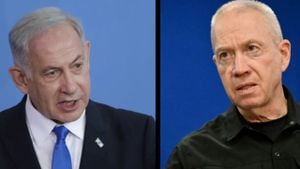China is reaching out to the United States, expressing its eagerness to engage in meaningful dialogues to bolster trade relations. This message was recently underscored by Wang Shouwen, China’s Vice Commerce Minister, who articulated the country's intentions during a press conference held in Beijing. Wang, who also serves as China's International Trade Representative, emphasized the importance of mutual respect between the two largest economies in the world.
Stressing the need for collaboration, Wang stated, "We believe China and the U.S. can maintain a stable, healthy, and sustainable development trend in economic and trade relations." His remarks come at a time when both countries are experiencing economic pressures, leaving many wondering whether softer diplomatic ties could lead to improved trade dynamics.
China’s willingness to expand areas of cooperation stands out as one of the bright spots amid growing tensions. Wang reiterated the commitment to actively seek areas of partnership and manage existing disagreements with the U.S. This dialogue has become increasingly necessary, especially with looming tariffs potentially implemented by the incoming U.S. administration under President-elect Donald Trump.
Speaking candidly about the potential fallout from Trump's stated plans to impose tariffs exceeding 60% on all Chinese goods, Wang acknowledged the anxiety circulating among Chinese manufacturers. The threat has already initiated discussions among many factories, forcing them to relocate to Southeast Asia and other areas to sidestep these punitive tariffs.
According to economists surveyed by Reuters, the U.S. could impose tariffs nearing 40% on Chinese imports early next year, which could knock off up to 1% from growth projections for the world's second-largest economy. The uncertainty is clearly weighing on China’s exporters, who are bracing for the potential disruptions these economic policies could bring.
On the heels of this backdrop, Chinese officials announced several policy measures aimed at boosting foreign trade. Authorities promised improved financing support to firms and indicated efforts to ramp up exports of agricultural products. Such strategic objectives come as part of China’s plan to tackle external economic shocks, bolster its economy, and maintain positive growth amid rising tariffs.
Transitioning to currency effects, the trade turbulence linked to Trump’s first term has also had significant ramifications for the Chinese yuan. Initially, the yuan saw gains of around 10% during the early months of his presidency, but as tariffs took effect, the currency slumped nearly 12%. Liu Ye, representing China's Central Bank, stated, "Our basic judgement is the yuan exchange rate will remain basically stable at a reasonable and balanced level," indicating confidence amid turmoil.
Liu went on to explain the central bank's plans to uphold the yuan's flexibility, strong guidance on market expectations, and efforts to stave off risks associated with currency volatility. China is also taking steps to mitigate currency risks by encouraging firms to hold more dollars, price contracts predominantly in yuan, and broaden import channels.
The message from Beijing is clear: through active engagement, China is seeking to stabilize its trading relationships, particularly with the U.S. as global economic uncertainty heightens. Analysts worldwide are watching closely to see if these diplomatic efforts might bear fruit, especially as economic forecasts remain uncertain.
China’s offers to resume dialogues come at a pivotal time, challenging the existing narrative of conflict and competition. The future of U.S.-China trade relations will likely hinge on how both nations approach the principles laid out by Wang and whether they can navigate their differences effectively to protect their economies from external shocks. The global economic community can only hope for constructive engagement moving forward.



